Sixty-six million years ago, the reign of the dinosaurs, a dynasty that had dominated Earth for an astonishing 180 million years, came to a cataclysmic end. This abrupt finale wasn’t due to gradual environmental shifts or evolutionary shortcomings, but rather a sudden, violent event of cosmic proportions: an asteroid impact.
Professor Paul Barrett, a leading dinosaur researcher at the Natural History Museum, sheds light on the events of that fateful day, piecing together the narrative of the dinosaurs’ demise and helping us understand exactly where this world-altering asteroid struck.
The Asteroid Impact Theory: A Cosmic Detective Story
The asteroid impact theory, which posits that a large asteroid collision led to the extinction of the dinosaurs, was first proposed in 1980 by Nobel laureate physicist Luis Walter Alvarez and his geologist son, Walter. Their groundbreaking research centered around a peculiar layer of clay, rich in the element iridium, found globally at the geological boundary marking the end of the Cretaceous period.
Iridium is rare in Earth’s crust but common in meteorites. The Alvarez team theorized that this iridium-rich layer was extraterrestrial in origin, deposited worldwide by the fallout from a massive asteroid impact. This impact, they argued, would have triggered immediate devastation and cascading secondary effects, ultimately causing the swift extinction of the dinosaurs and many other life forms.
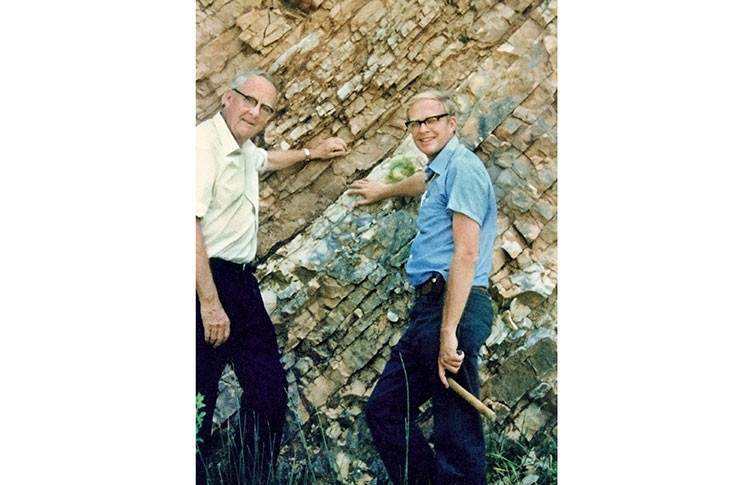 Luis Walter Alvarez and his son Walter Alvarez
Luis Walter Alvarez and his son Walter Alvarez
Pioneering the Asteroid Extinction Theory: Luis Walter Alvarez (left) and his son Walter (right) revolutionized our understanding of dinosaur extinction with their asteroid impact hypothesis, linking a cosmic event to the disappearance of non-avian dinosaurs 66 million years ago. Image courtesy of Lawrence Berkeley Laboratory/ Wikimedia Commons.
Initially met with skepticism, the Alvarez hypothesis has since become the most widely accepted explanation for the mass extinction event that marks the boundary between the Mesozoic and Cenozoic Eras, often referred to as the K-Pg extinction event.
Locating the Dinosaur-Killing Asteroid: Unearthing the Chicxulub Crater
The crucial evidence supporting the asteroid impact theory came with the discovery of the impact crater itself. As Professor Barrett explains, “An asteroid impact is strongly supported by compelling evidence, most notably the identification of the impact crater. This massive crater, known as the Chicxulub crater, is now largely submerged and buried beneath the seafloor off the coast of Mexico. Remarkably, its age precisely matches the timing of the non-avian dinosaur extinction, a correlation consistently observed in the global rock record.”
The Chicxulub crater, pinpointing where the asteroid that killed the dinosaurs struck, is centered on the Yucatán Peninsula in Mexico. This location places the impact event in the Gulf of Mexico region.
Geophysical surveys and drilling projects have revealed the immense scale of the Chicxulub crater. Scientists estimate the asteroid itself was a colossal object, likely between 10 to 15 kilometers in diameter. The sheer force of its impact, colliding with Earth at tremendous velocity, excavated a crater far larger than the asteroid itself, measuring an astonishing 150 kilometers in diameter and tens of kilometers deep initially. Today, it stands as the second-largest confirmed impact crater on our planet, a stark reminder of the colossal forces at play in Earth’s history.
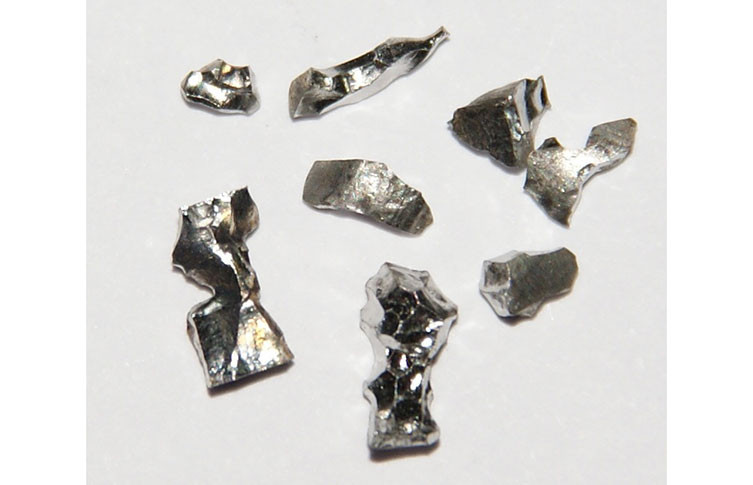 Pieces of iridium
Pieces of iridium
Iridium as a Key Indicator: The presence of iridium, a rare metal on Earth but more common in extraterrestrial bodies, in geological layers dating back to the dinosaur extinction event, provides strong evidence for an asteroid impact. © Hi-Res Images of Chemical Elements/ Wikimedia Commons (CC BY 3.0).
The impact at Chicxulub was not just geographically localized. It unleashed a chain of global catastrophes. The collision ejected vast quantities of pulverized rock, dust, and vaporized material high into the atmosphere. Massive tsunamis, triggered by the impact, surged across the ancient oceans, inundating coastlines, particularly in the Americas. Furthermore, evidence suggests that the impact ignited widespread wildfires, further contributing to atmospheric pollution.
While earlier estimations placed the dinosaur extinction at 65 million years ago, precise radiometric dating of the iridium-rich clay layers around the world has refined this timeline. Professor Barrett notes, “The dating of these clay layers is exceptionally accurate, with estimations precise to within a couple of thousands of years. Recent redating efforts have further refined the timeline, establishing the dinosaur extinction event at 66.0 million years ago.” This refined dating firmly links the Chicxulub impact event to the precise moment of the dinosaur extinction.
How Did the Chicxulub Asteroid Cause a Mass Extinction?
The Chicxulub impact, the site where the asteroid that killed the dinosaurs landed, triggered a cascade of environmental disasters that led to the extinction of approximately 75% of plant and animal species on Earth, including the non-avian dinosaurs. How did an impact in the Gulf of Mexico have such global and devastating consequences?
Professor Barrett explains the kill mechanisms set in motion by the asteroid: “The asteroid’s high-velocity impact caused instantaneous vaporization of both the asteroid and a significant portion of the Earth’s crust at the impact site. This created an enormous crater and unleashed a devastating blast wave and heatwave radiating outwards. Crucially, it also propelled colossal amounts of debris, including soot from wildfires, into the upper atmosphere, distributing it globally.”
This global shroud of dust and soot had profound and long-lasting effects on Earth’s climate and ecosystems. While it might not have completely blacked out the sun, it significantly reduced the amount of sunlight reaching the Earth’s surface. This reduction in solar radiation dramatically hampered photosynthesis, the process by which plants convert sunlight into energy.
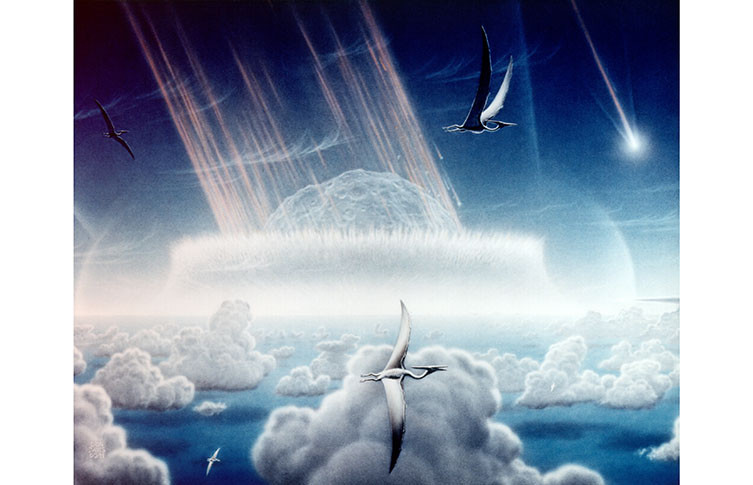 An illustration of an asteroid impacting Earth
An illustration of an asteroid impacting Earth
Artist’s Depiction of the Chicxulub Impact: An illustration showcasing the immense shockwave emanating from the asteroid’s impact on the Yucatán Peninsula, highlighting the immediate devastation in the surrounding region. Image by Donald E Davis courtesy of NASA/JPL-Caltech, via Wikimedia Commons.
The collapse of plant life at the base of the food chain initiated a domino effect throughout the ecosystems. Herbivorous dinosaurs, dependent on plants for food, faced starvation. Subsequently, carnivorous dinosaurs, preying on herbivores, also suffered from food scarcity. Breeding seasons would have been disrupted, and environmental conditions became increasingly harsh for all life forms, both on land and in the oceans.
“The precise kill mechanism and the duration of this extinction period are still subjects of ongoing scientific debate and research, with many unknowns remaining. However, it is undeniable that the Chicxulub impact was a catastrophic event that profoundly affected all life on Earth, from microscopic organisms to the giant dinosaurs,” Professor Barrett emphasizes.
Beyond the dinosaurs, the K-Pg extinction event claimed numerous other groups, including ammonites, various types of plankton, and large marine reptiles. However, this very destruction paved the way for the rise of the modern world and the diversification of surviving lineages.
The Role of Deccan Traps and Pre-Existing Climate Change
While the asteroid impact at Chicxulub is considered the primary driver of the dinosaur extinction, it’s important to acknowledge that Earth’s environment was already undergoing significant changes prior to the impact. Volcanic activity in the Deccan Traps region of present-day India played a significant role in destabilizing the global climate.
For approximately two million years leading up to the K-Pg boundary, massive volcanic eruptions in the Deccan Traps spewed immense quantities of greenhouse gases and aerosols into the atmosphere. This prolonged volcanic activity caused significant disruptions to global climate patterns, contributing to environmental stress for existing ecosystems.
Professor Barrett elaborates, “For millions of years, intense volcanic activity in the Deccan Traps was releasing substantial amounts of gases into the atmosphere, profoundly impacting the global climate. Coupled with these volcanic effects, long-term geological changes, such as continental drift and the widening of oceans, were also altering ocean currents and atmospheric circulation patterns, further influencing global climate and vegetation.”
These pre-existing environmental stresses, caused by volcanic activity and long-term climate shifts, may have already made ecosystems more vulnerable. The asteroid impact, therefore, acted as a final, decisive blow to already weakened ecosystems, pushing them beyond their capacity to recover.
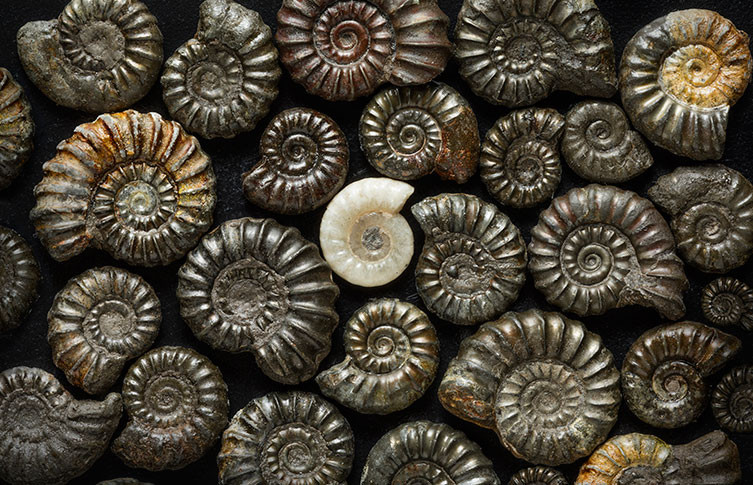 A selection of ammonites from the Museum
A selection of ammonites from the Museum
Ammonites: Victims of the Cataclysm: Ammonites, a diverse group of shelled cephalopods, were among the many marine species that vanished during the Cretaceous-Palaeogene extinction event, 66 million years ago. Their fossils serve as poignant reminders of the widespread loss of biodiversity during this period.
The last non-avian dinosaurs were living in a world undergoing significant environmental upheaval. The Chicxulub asteroid impact, landing in what is now the Yucatán Peninsula, delivered the final, extinction-level catastrophe.
Life After the Asteroid: Survivors and the Dawn of Mammals
Despite the magnitude of the K-Pg extinction, life on Earth did not entirely perish. Plants, in general, proved more resilient than animals, largely due to the survival capabilities of their seeds and pollen during harsh environmental conditions. In the aftermath of the dinosaur extinction, flowering plants flourished, continuing their dominance that had begun in the Cretaceous period and continues to this day. However, among land animals, a size threshold existed for survival: all land animals weighing over 25 kilograms went extinct.
Professor Barrett explains the selective nature of the extinction and the subsequent recovery of life: “The survivors of the K-Pg extinction essentially represent the foundation of modern biodiversity. Many major animal groups present today existed before the asteroid impact and experienced some level of extinction, but the lineages that ultimately led to modern animal groups managed to persist.”
Notably, while all non-avian dinosaurs perished, dinosaurs did survive in the form of birds. Although some bird lineages also went extinct, the ancestors of modern birds successfully navigated the extinction event.
Initially, the post-impact world was dominated by smaller animals. Birds were among the first to evolve towards larger sizes again. Briefly, lineages of giant flightless birds emerged, but these too eventually went extinct.
 The fossilised skull of an extinct flightless bird
The fossilised skull of an extinct flightless bird
Echoes of a Lost World: A fossilized skull of a Diatryma, a large flightless bird from the Eocene Epoch (around 50-55 million years ago), exemplifies the early evolution of large birds in the aftermath of the dinosaur extinction, filling ecological niches left vacant.
“It wasn’t until approximately 15 million years after the non-avian dinosaurs disappeared, during the Oligocene Epoch, that truly large mammals began to reappear. This period marks the resurgence of rhino-sized animals. However, in the interim, the world was primarily populated by smaller animals, a stark contrast to the world dominated by dinosaurs that preceded them. It took millions of years for body size to catch up to the giants of the Mesozoic,” Professor Barrett concludes.
Dinosaurs remain the largest land animals to have ever lived, surpassed in size only by whales, which inhabit the oceans.
What If the Asteroid Had Landed Elsewhere?
Intriguingly, recent research suggests that the location of the Chicxulub impact played a crucial role in the severity of the extinction event. Had the asteroid struck a different location on Earth, the consequences for life might have been significantly less catastrophic. If the impact had occurred just minutes later in its trajectory, it would have landed in deeper ocean waters. This scenario could have resulted in less vaporized rock and reduced ejection of sunlight-blocking debris into the atmosphere, potentially lessening the severity of the mass extinction.
However, the asteroid did strike the Yucatán Peninsula, impacting a region rich in sulfate-bearing rocks. The vaporization of these rocks released sulfur aerosols into the atmosphere, exacerbating the cooling effect and acid rain, further intensifying the environmental devastation.
Despite the cataclysm, Professor Barrett speculates on a world where the asteroid missed Earth entirely:
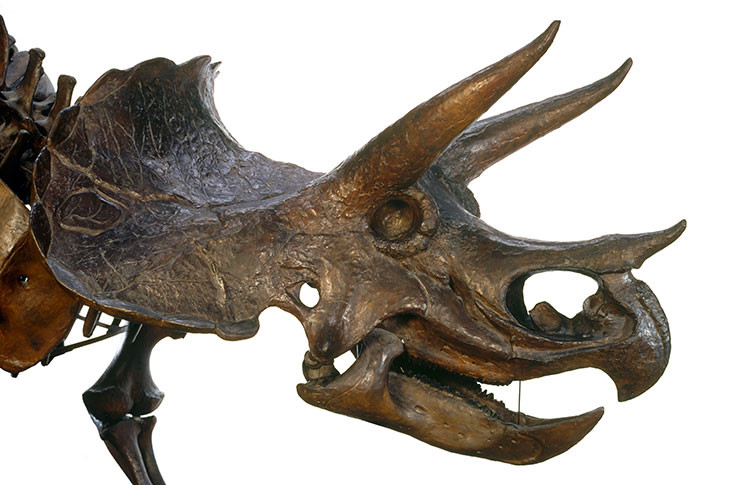 A Triceratops skeleton
A Triceratops skeleton
Triceratops: A Symbol of a Lost World: Triceratops, one of the last non-avian dinosaurs, represents the potential for continued dinosaur evolution had the asteroid impact not occurred. Their descendants might have roamed the Earth today, alongside modern fauna.
“I suspect that some non-avian dinosaurs might still be present today if the asteroid had not struck. Our understanding of the final 10 million years of their reign is limited, primarily based on fossil records from western North America. This region shows thriving dinosaur populations in terms of numbers, although with a reduction in the diversity of dinosaur types. Whether this pattern held true globally remains a significant mystery.”
Even without the asteroid, the rise of birds, mammals, and reptiles was underway. While dinosaurs might have persisted longer, they may not have maintained the same level of dominance they once held.
The Chicxulub crater in Mexico stands as a silent testament to the asteroid impact that ended the age of dinosaurs, a pivotal moment in Earth’s history that reshaped the course of life on our planet. Understanding where the asteroid that killed the dinosaurs struck and the ensuing consequences provides invaluable insights into the fragility of ecosystems and the profound impact of cosmic events on Earth’s biosphere.
